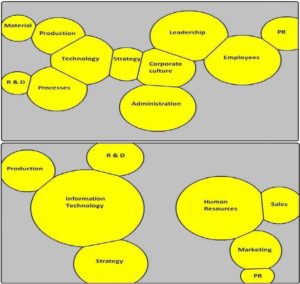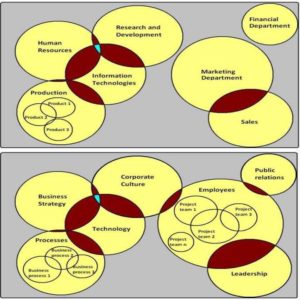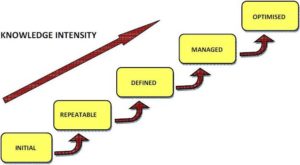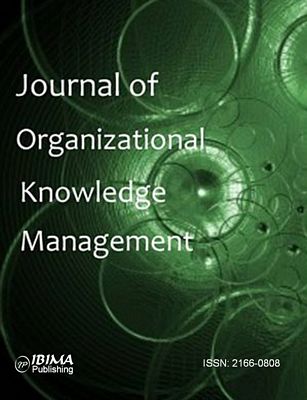Introduction
Obtaining and retaining the competitive advantage is the primary task of all subjects not only from the organisational perspective. As discussed within various sectors and industries, knowledge is considered to be one of the rare renewable resources (Davenport and Prusak, 1998, van Zolingen, Sreumer and Stooker, 2001), which moreover possesses a significantly substantial innovative potential and therefore can be further developed.
It is necessary to measure and monitor the ability and willingness of particular subjects to effectively use knowledge, especially for the purposes of the comparison of their capabilities and market position. The aim of this paper is to establish theoretical fundaments of the knowledge intensity modelling which might represent a utilisable tool for the organisational evaluation and comparison in the realm of their competitiveness. Firstly, the paper determines the knowledge intensity concept and its context. In the next part three potential approaches to the knowledge intensity measurement are outlined. These are represented by the
additive, multiplicative and incremental model of knowledge intensity. In the next section of this paper, both the limitations of the knowledge intensity modelling and further research options are mentioned and analysed. Finally, the discussed issues are concluded.
Knowledge Intensity Definition and its Context
The knowledge intensity measurement aims to provide another indicator of competitiveness monitoring not only at the organisational level, but also for the purposes of the comparison of entire sectors, national economics as well as supranational units. This indicator might also enable the identification of organisational potential and the areas (‘gaps’) for further improvement of the efficiency of the organisational and related knowledge processes.
The knowledge intensity can be considered as a distinctive characteristic of the company department, organisation, a particular sector or the whole country perceived as a complex technical-economical-social system (Mildeová, 2005), and therefore should be modelled and monitored. As mentioned earlier, knowledge intensity might be measured at the organisational level.
Chan argues that ‘knowledge intensity increases with the rising complexity of business processes’ (2009, 161). Moreover, Andreeva and Kianto (2011) prove its influence on the organisational innovation performance. Although the knowledge intensity is mentioned (Andreeva and Kianto, 2011, Makani and Marche, 2012), the particular and utilisable models are neither outlined nor discussed. Therefore, this paper focuses on the organisational perspective, because these issues are usually omitted and there are hardly any potential options of the quantification of the knowledge and related processes.
Autio (2000) defines knowledge intensity as the extent to which a firm depends on its knowledge as a source of competitive advantage. Davenport and Smith (2000) assert that knowledge-intensive companies will allocate more resources to knowledge management. Prashantham (2008) links the knowledge-intensive firms with the majority of workforce being highly qualified and engaged in knowledge work.
He considers knowledge as inherent within the organisational knowledge-intensive activities. Willoughby and Galvin (2005) state that knowledge intensity positively relates to the extent of research and development activities, represents an internal source of innovations and determines the organisational ability to innovation processes.
Makani and Marche (2010) claim that the knowledge intensity comprises two critical dimensions – the worker and the organisation. Nevertheless, they emphasise that there is hardly any consensus on the definition of neither the knowledge intensity nor the knowledge-intensive organisation.
The aforementioned confirms particular findings and interest in the discussed issues. Nevertheless, the criteria with which would enable the classification of organisations according to their knowledge intensity are not described. For the purposes of this paper the knowledge intensity can be defined as an extent of the knowledge potential utilisation within the organisation.
Potential Possibilities of Knowledge Intensity Measurement
Various approaches and ways of perception to knowledge intensity are identifiable within the professional literature. The World Bank Knowledge Index or the Knowledge Economy index (Chen and Dahlman, 2005) are available for the comparison at the national level. At the individual level, the intensity of knowledge work (Holsapple, 2003) can be evaluated or the knowledge work intensity score can be assigned to particular tasks of an individual worker (Ramirez and Streudel, 2008).
Nevertheless, the explicit description of ways how to measure the knowledge intensity at theorganisational level has not been properly introduced yet. So far, only a general framework of knowledge intensity modelling was introduced (Bureš and ÄŒech, 2007), but no particular models have been described. One of the reasons is the situational complexity and the necessity of considering the organisational context (Bureš, 2007).
Among influential factors, the following can be mentioned: company size, financial results, organisational image, vision, strategy, structure, culture or the proficiency of management. The amount of the investments into science, research and education or whether the company is able to utilise the advantages of programmes supporting the innovations should be included among such aspects as well.
Knowledge Intensity Models
The knowledge intensity, similarly to other indicators and processes, can be modelled utilising various methods and approaches exemplified by the conceptual modelling (Otčenášková, Bureš and ÄŒech, 2011) and formal or informal modelling (Mikulecký, 2010).
The question – which approach offers the most accurate and the most practically utilisable result which would moreover enable the comparison of organisational development, various companies from a certain sector or different economic sectors among themselves in time – remains vague. In this paper three basic models are introduced.
The first one is the additive model, the second one is the multiplicative model and the third one is the incremental model. These concepts are described in more detail below.
Additive Model of Knowledge Intensity
This model assumes that there are particular components within each organisation linked with knowledge and the extent of its utilisation considering the organisational potential. These components can fulfil the hypothetical maximal potential and therefore can be summed up.
These parts can be represented by the essential organisational elements exemplified by the strategy, culture, process, structure, power&politics and information technology (Cao, Wiengarten and Humphreys, 2011) or by the technological infrastructure, organisational infrastructure, strategic leadership, organisational learning and knowledge culture (Å ajeva, 2010). Within this paper, even more elements are utilised – these are employees, technologies, leadership style, and the like. The additive model represents the elementary model of knowledge intensity measurement and therefore supposes the highest level of simplification represented by the independence of the included components.
Therefore, the mechanistic approach can be employed to support this model construction. It grounds from the principle of reductionism and is based on the analysis of the whole system which is decomposed to basic elements which are further indivisible. The useful and supportive parallel classification of knowledge considering the level of detail can be used as well. Such concept was introduced by Wiig, de Hoog and van der Spek.
They distinguish various knowledge spans – from knowledge domain, through sequential specification including knowledge region, knowledge section, knowledge segment, knowledge element and knowledge fragment to knowledge atoms (Wiig, de Hoog and van der Spek, 1997).
The particular problems – in other words the mentioned atoms – can be consequently solved and dealt individually. When evaluated and summed up, these components practically represent the extent of the knowledge organisational intensity for the purposes of the additive model. If there is a need to increase the knowledge intensity of the organisation, the individual enhancement of a particular component would be sufficient without the reference to other elements or departments of the organisation.
From the theoretical perspective of the model, the ideal situation represents the presence of all components and their maximal utilisation within the organisation, possibly the maximal utilisation of the organisational potential.
Regarding the provision of comparability, firstly it is crucial to convert all the particular components to the same measurement unit or dimension. For these purposes, the ideal way seems to be the percentage scale where 0 % represents the absence or absolutely ineffective utilisation of a particular component, and 100 % signifies maximal, mostly only hypothetical, in practice hardly achievable, utilisation of a particular component. The enumeration of the components possibly incorporated in the model aspirates to be relatively long whereas the above described components can be hierarchically decomposed through various levels to basic ‘building blocks’ which would enable to determine the extent of knowledge intensity (for example the classification to particular information, knowledge and communication technologies).
Nevertheless, in practice the component might not even be present at all within the company. If the overall organisational potential is completely fulfilled by particular components, the company might be considered as 100 % knowledge-intensive no matter whether the organisation is more focused on employees and the organisational culture or whether it prioritises the processes and technologies.
Not only two organisations can be compared. The additive model might facilitate the comparison of particular departments within the organisation or the monitoring of various units. The described approach based on the additive model is general and signifies its usability nearly for any purposes of such monitoring.
The fundamental blocks of the model can differ. Figure 1 illustrates this fact and exemplifies it while depicting the organisational and departmental modelling showing their potential basic elements. Obviously, the modelling can follow different perspectives. The appropriate one should be chosen according to the current conditions and demands of the monitoring.

Fig 1. Additive Model: A – Organisational Components (Upper), B – Organisational Departments (Bottom) [Source: Author’s Research]
To increase the knowledge intensity, a lot of activities and programmes can be employed. These might be exemplified by the establishment of knowledge manager position, the creation of the company university, quality circles, discussion forums and similar initiatives. The extent of the utilisation of these activities and their real (if any) contribution to the organisational knowledge intensity are not often necessarily unambiguous.
The motivation of employees and other engaged subjects is undoubtedly another important part of the success of activities relating to the knowledge processes. Relative percentage share of particular components within the potential is therefore significantly different. Nevertheless, the definition of particular components itself remains arguable.
The vague issues include for example the distinction of knowledge workers and knowledge processes or whether the extent of innovations within the company contributes to these processes. The determination of the most important component which should be represented to the higher extent is also controversial.
This fact is naturally dependent not only on the internal factors and organisational characteristics, but also on the sector in which the company operates.
Multiplicative Model of Knowledge Intensity
The multiplicative model is based on the principles of multiplying particular elements of the system. Similarly to the additive and incremental model, the particular subsystems are ‘put’ together and their overall fulfilment and utilisation of the organisational potential is assessed.
In comparison with the additive model, this model assumes the interconnectedness of particular components and their dependence. Practically, this model seems to be more precise as well as relevant considering the usual reality within the companies/systems. Each element within the organisation or its department usually relates to one or more components. Some components are influenced by other ones and therefore overlapped (see Figure 2). Such overlays represent the connected areas which provide higher value added to the organisation, because the synergic effects emerge. There are parts included in more elements which increase the potential utilisation in more areas. As illustrated in Figure 2, the new technology implementation would positively influence more components than just itself. It would support the business strategy, improve organisational processes and enhance corporate culture.

Fig 2. Multiplicative Model: A – Organisational Components (Upper), B – Organisational Departments (Bottom) [Source: Author’s Research]
The elementary organisational elements are assessed for the purposes of both the additive and multiplicative models. Nevertheless, in the additive model these are summed up whereas the multiplicative model necessitates the multiplication of the overlapped components instead of the simple sum. The overall result of the extent of the organisational knowledge intensity is better – this means that the value of the knowledge intensity indicator is higher. The knowledge management can be considered as a useful ‘tool’ how to interconnect the particular components of the organisation or its departments to ensure higher values of the knowledge intensity index.
Incremental Model of Knowledge Intensity
The knowledge intensity incremental model differs from the aforementioned significantly. It is based on the idea of the Capability Maturity Model Integration (CMMI) where the maturity of the organisation is monitored.
The implementation of the model is utilisable for the organisational efficiency improvement and its application would therefore represent an option how to monitor the progress of working with the knowledge within the organisation (Software Engineering Institute, 2011). Each organisation begins at the first, the least knowledge-intensive, level. The advancement to the next level, represented by the following maturity phase, is possible only when appropriate assumptions and conditions are fulfilled. Figure 3 illustrates all particular levels which can be achieved.

Fig 3. Application of CMMI Concept to Knowledge Intensity Modelling [Source: Author’s Research]
The general – but more precise – overview of the description of the conditions necessary for the next level advancement is illustrated in Table 1 and the particular phases are introduced later. Nevertheless, the assumption of the enhancement is based on the principle that each level represents a particular added value what means that the previous level conditions remain accomplished and new improvements emerge. This paper is focused on the organisational level and therefore describes mostly the advancement from the perspective of knowledge processes because of their importance and the interconnectedness to other components.
Table 1: Conditions of Particular the Advancement to the Next Level [Source: Author’s Research]

In the initial phase, the knowledge-oriented activities and process are chaotic, their management is not coordinated and the work with knowledge within the organisation remains neither systematic nor systemic. The knowledge utilisation emerges only on the urgency basis, knowledge is found at the moment when is necessary to quickly find the solution. However, hardly anybody knows who possesses which knowledge, who can be contacted in a certain situation, and so on.
The shift to the phase called repeatable is possible when the accomplishment of at least primary demands on activities and knowledge processes within the company is realised. At this level, these should be repeatedly applied. This means the possibility of the employment of the same – already proven – procedures and the avoidance of repeating the same mistakes and lapses experienced by the company in the past. This phase ensures to a limited extent the cost reduction of financial means used for both the searching of potential ways how to realise the activities and the effort to discover already known solutions of a particular problem.
The condition of the advancement to the phase defined is the provision of the option to determine, document and codify the particular processes. These are afterwards more easily applicable within various contexts. Moreover, the knowledge strategy is explicitly applied and shared within the organisation.
The level managed denotes the ability of the organisation to effectively control and flexibly apply knowledge during their management. The advancement to this phase requires the determination of knowledge strategy for the given company with particular linkage to business strategy. Potentially the knowledge manager might be formally appointed.
The organisation being at the highest level – the optimised one – is able to improve its processes continually and apply the innovations to them. From the technological perspective, the employment of Ambient Intelligence technologies at the workplace is realisable and would support the processes and correspondingly enhance the organisational knowledge intensity (Mikulecký, 2007). Moreover, the strategic vision and knowledge strategy are effectively interconnected with the business strategy and support it. Therefore, significant cost reduction and competitiveness improvement occur.
The implementation of CMMI and its application in practice should facilitate not only the efficiency and effectiveness enhancement of the organisational activities, but also the quality improvement.
Limitations and Further Research
The general methodology can be considered as an initial overview of potential options how to measure the knowledge intensity. Nevertheless, the organisational context with its specifics certainly necessitates to be taken into account. Moreover, the discussed issues are complex as well as dynamic and uncertain. Therefore, this realm generally evokes more areas for further research.
Firstly, the current monitoring of ‘knowledge intensity’ within organizations together with their attitude to issues linked with knowledge should be researched and evaluated to recognise which areas compel the most attention. This process would afterwards enable better resource allocation and more appropriate investments. Not only the current state should be mapped, but the results are usable for the long-term sustainability of the organisational prosperity.
Secondly, the methodology itself should be tested in practice. For example, a case study relating to these issues would be useful for both the practical usability and the identification of the model weaknesses. The potential areas for appropriate improvements will be revealed and aptly amended or included.
Moreover, the fact that a lot of particular input parameters are qualitative complicates the indicator determination. Subjectivity of their perception and definition influences their identification and measurement. Therefore, the standardisation and optimisation would contribute to the elimination of these unfavourable phenomena and to the increase of indicator comparability.
Furthermore, the formalisation of the models and indicator determination represents not only a difficult challenge, but nearly a need for its further utilisation and wider applicability. The formalised and more precise results would support the organisational competitiveness enhancement. On the contrary, the employment of all the mentioned knowledge intensity measurement improvements is connected with higher demands on financial, time, human and technical resources during the measurement process and during the identification of potential gaps for advances. This would consequently make this process more problematic and less realisable for organisations.
At the moment, some potential options of knowledge intensity modelling and measurement are outlined. Nevertheless, these concepts require to be further elaborated and their usability afterwards verified in praxis within certain organisations through their various types, sectors, category of economic activity, main innovation focus, and the like. This process should ensure the increase of knowledge intensity indicator relevancy together with its higher applicability. Moreover, it should provide the determination of weights of particular components from the perspective of various subjects operating within different spheres. Possibly, the appropriateness of various approaches and models will be proved for the purposes of various sectors, companies and the like. These differences might be revealed while examining the models practically.
Conclusion
Currently, the tool utilisable for the measurement of knowledge and organisational potential utilisation at the organisational level is not available. Therefore, this paper deals with the introduction of theoretical fundaments of a knowledge intensity concept usable for such purposes – the evaluation of organisational weaknesses, the identification of areas of further improvement and development and the consequent increase of its competitiveness. Three models of knowledge intensity modelling are described. These include the additive, multiplicative and the incremental one. Nevertheless, it remains important to up-to-date and amend the mentioned models and approaches according to the topical situational development and to changing internal and external conditions from both perspectives – the practical and theoretical one.
Acknowledgement
This paper was written with the support of specific research project ‘The Research of the Ambient Intelligence Technologies Impact on the Intellectual Capital Development’ which is a part of a GAÄŒR project SMEW – Smart Environments at Workplaces No. 403/10/1310 and the project ‘Innovation and support of doctoral study program (INDOP)’ No. CZ.1.07/2.2.00/28.0327 financed from EU and Czech Republic funds.
References
Andreeva, T. & Kianto, A. (2011). “Knowledge Processes, Knowledge-Intensity and Innovation: A Moderated Mediation Analysis,” Journal of Knowledge Management, 15(6), 1016-1034.
Publisher – Google Scholar
Autio, E., Sapienza, H. J. & Almeida, J. G. (2000). “Effects of Age at Entry, Knowledge Intensity, and Imitability on International Growth,” Academy of Management Journal, October 2000.
Publisher – Google Scholar – British Library Direct
Bureš, V. & ÄŒech, P. (2007). “Complexity of Ambient Intelligence in Managerial Work,” ITICSE 2007: 12th Annual Conference on Innovation & Technology in Computer Science Education, Dundee (Scotland): University of Dundee, 325-325.
Publisher – Google Scholar – British Library Direct
Bureš, V. & ÄŒech, P. (2007). ‘Knowledge Intensity of Organizations in Knowledge Economy,’ INSTICC: 3rd International Conference on Web Information Systems and Technologies, Barcelona (Spain), 210-213.
Cao, G., Wiengarten, F. & Humphreys, P. (2011). “Towards a Contingency Resource-Based View of IT Business Value,”Systemic Practice & Action Research, 24(1), 85-106.
Publisher – Google Scholar
Chan, J. O. (2009). “A Conceptual Framework for an Integrated Knowledge-Driven Enterprise Model,” Journal of International Technology and Information Management, 18(2), 161-185.
Publisher
Chen, D. H. C. & Dahlman, C. J. (2005). “The Knowledge Economy, the KAM Methodology and World Bank Operations,” [Online], The World Bank, [Retrieved November 16, 2011], Available:http://siteresources.worldbank.org/KFDLP/Resources/KAM_Paper_WP.pdf.
Publisher
Davenport, T. H. & Prusak, L. (1998). Working Knowledge. 1st edition, Boston: Harvard Business School Press, ISBN: 0875846556.
Publisher
Davenport, T. H. & Smith, D. E. (2000). “Managing Knowledge in Professional Service Firms,” The Knowledge Management Yearbook 2000-2001, Oxford: Butterworth-Heinemann.
Publisher – Google Scholar
Holsapple, C. W. (ed.) (2003). Handbook on Knowledge Management: Knowledge Matters. 1st edition, Berlin –Heidelberg: Springer-Verlag, ISBN: 3-540-43527-1.
Publisher – Google Scholar
Makani, J. & Marche, S. (2010). “Towards a Typology of Knowledge-Intensive Organizations: Determinant Factors,”Knowledge Management Research & Practice, 8(3), 265-277.
Publisher – Google Scholar
Makani, J. & Marche, S. (2012). “Classifying Organizations by Knowledge Intensity – Necessary Next-steps,” Journal of Knowledge Management, 16(2), 243-266.
Publisher – Google Scholar
Mikulecký, P. (2007). ‘Ambient Intelligence in Decision Support,’ 7th International Conference on Strategic Management and its Support by Information Systems, Celadna (Czech Republic), 48-58.
Google Scholar
Mikulecký, P. (2010). “Possibilities for Formal Models of Smart Environments,” DNCOCO 10: 9th WSEAS International Conference on Data Networks, Communications, Computers, University Algarve, Faro (Portugal). In: Advances in Data Networks, Communications, Computers, Book Series: Advances in Data Networks Communications Computers-Proceedings, Mastorakis N. E. and Mladenov, V. (eds.), 131-136.
Publisher – Google Scholar
Mildeová, S. (2005). ‘The Principles of System Dynamics Towards Balanced Scorecard Implementation,’ 13th Conference on Interdisciplinary Information Management Talks, Budweis (Czech Republic): Schriftenreihe Informatik, Book Series, 16, 119-127.
Otčenášková, T., Bureš, V. & ÄŒech, P. (2011). ‘Conceptual Modeling for Management of Public Health in Case of Emergency Situations,’ International Conference on Knowledge Engineering and Ontology Development, Paris (France), 344-348.
Prashantham, S. (2008). The Internationalization of Small Firms: A Strategic Entrepreneurship Perspective. USA, Canada: Routledge.
Publisher – Google Scholar
Ramirez, Y. W. & Streudel, H. J. (2008). “Measuring Knowledge Work: The Knowledge Work Quantification Framework,”Journal of Intellectual Capital, 9(4), 564-584.
Publisher – Google Scholar
Software Engineering Institute. (2011). “Capability Maturity Model Integration,” [Online], Carnegie Mellon, [Retrieved November 25, 2011], Available: http://www.sei.cmu.edu/cmmi/.
Publisher
Å ajeva, S. (2010). “The Analysis of Key Elements of Socio-Technical Knowledge Management System,” Economics & Management, 765-774.
Publisher – Google Scholar
van Zolingen, S. J., Streumer, J. N. & Stooker, M. (2001). “Problems in Knowledge Management: A Case Study of a Knowledge-Intensive Company,” International Journal of Training & Development, 5(3), 8-185.
Publisher – Google Scholar – British Library Direct
Wiig, K. M., de Hoog, R. & van der Spek, R. (1997). “Supporting Knowledge Management: A Selection of Methods and Techniques,” Expert Systems with Applications, 13(1), 15-27.
Publisher – Google Scholar – British Library Direct
Willoughby, K. & Galvin, P. (2005). “Inter-Organizational Collaboration, Knowledge Intensity, and the Sources of Innovation in the Bioscience-Technology Industries,” Knowledge, Technology, & Policy, 18(3), 56-73.
Publisher – Google Scholar – British Library Direct







